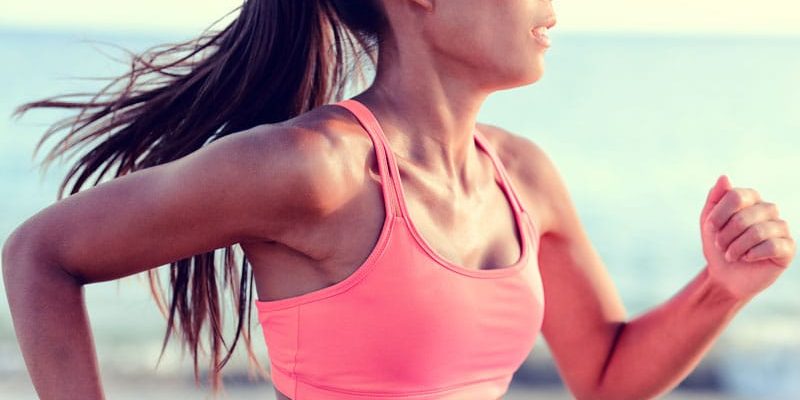SAN DIEGO — Greater breast support was associated with reduction in impact factors contributing to traumatic knee injuries including ACL rupture, based on data from 14 female college athletes.
“We know that female athletes have a higher risk of ACL injury compared to males in the same sport, with the highest risk between ages 15 and 18,” Hailey Fong, MS, a PhD student at the University of Memphis, told Medscape in an interview.

Hailey Fong
“Breast tissue is passive tissue. There is no muscle, so it moves the way it wants to,” she explained. “The idea behind the study was that having greater breast support changes trunk flexion,” and previous research suggests that landing with greater flexion decreases the risk for ACL injury, she added.
Breast support has been shown to alter trunk biomechanics during running, and trunk orientation on landing has been shown to mediate risk factors for ACL strain, but the effects of improved breast support on knee joint biomechanics have not been investigated, noted Fong and colleagues in the poster, presented earlier this month at the annual meeting of the American College of Sports Medicine.
For the study, the researchers recruited 14 female college athletes to perform five trials of a double-limb landing task at 40 cm under each of three sports bra conditions: no support, low support, and high support. The researchers measured kinematics and ground reaction forces (GRF) and used visual 3D to analyze and calculate peak angles for trunk segment and knee joint, and for knee extension moments.
Overall, increased levels of breast support were significantly associated with reductions in peak knee flexion (P = .008), peak knee valgus (P = .011), and peak knee valgus moments (P = .033,). Changes in general peak knee moments did not reach statistical significance (P = .216).
Greater breast support also significantly increased trunk flexion at the point of initial contact (P = .024) and peak trunk flexion (P = .002).
The data show how multiple joints adapt in response to low breast support in a way that increases risk of traumatic knee injury, including ACL rupture, but that increased breast support mitigated this risk, Fong said in an interview.
The researchers also measured vertical breast displacement. Not surprisingly, displacement was significantly lower with high support compared to low or no support with displacement of 2.4 cm, 3.0 cm, 4.4 cm for the left breast and 2.4 cm, 3.1 cm, 4.3 cm for the right breast, respectively.
“We were shocked that there was such a significant difference even between low and high support,” Ms. Fong said. The study population included women with cup sizes ranging from B to DD. “Even for those with a B cup, this means something,” she said.
The take-home message is the need to educate female athletes that support does matter, and a that sports bra is more than fashion or “something you just put on your body,” said Fong. A supportive sports bra not only eases breast discomfort and pain during exercise, but the study findings illustrate that “support actually changes the way you move.”
The study was limited by the small sample size and the self-reported bra size, as many women don’t know their correct size, Fong added. “One of the things we want to look at in the future is breast volume,” and get female athletes in correctly sized and supportive sports bras, she said.
Enhanced Need for Breast Studies in Sports
“Breast health is an understudied area in sports medicine,” Michele LaBotz, MD, of InterMed Sports Medicine, South Portland, Maine, told Medscape. “These findings regarding the impact of breast support on the biomechanics of impact activity should prompt future study in this area.”
Previous studies have shown that breast support affects upper extremity mechanics and strain during exercise, “but to see these impacts on lower-extremity mechanics is interesting,” noted LaBotz, who was not involved in the study.
Consequently, clinicians should be aware that “enhanced breast support in activities where females are landing from approximately 15 inches in height is associated with mechanical changes that may reduce the risk for knee ligamentous injury, such as ACL and/or MCL.”
However, “although the findings in this study are statistically significant, the clinical significance of these findings and the real impact of these findings on injury risk is uncertain,” LaBotz emphasized. “This study captured measurements at one instant in time (i.e. 100 milliseconds after landing contact), but other studies suggest that the pattern of landing mechanics which happen over a longer time period may be a better predictor of injury risk.”
LaBotz proposed several areas for further study. First, “more dynamic assessments of the impact of breast support on landing patterns over a longer period after landing contact, rather than an instantaneous assessment at a single timepoint,” are needed.
Second, research is needed on the role of age and pubertal status on the changes associated with improved breast support; for example, whether younger females show greater differences than more mature females in movement mechanics as a result of improved breast support, LaBotz said.
Third, the role of breast size on the changes associated with improved breast support deserves further study, such as whether these effects are more or less pronounced in females with greater breast mass, she added.
The study was supported by the American Athletic Conference Research Symposium. The researchers had no financial conflicts to disclose. LaBotz reported no relevant financial relationships.
American College of Sports Medicine 2022 annual meeting: Abstract 463. Presented June 1, 2022.
For more news, follow Medscape on Facebook, Twitter, Instagram, YouTube, and LinkedIn
Source: Read Full Article
